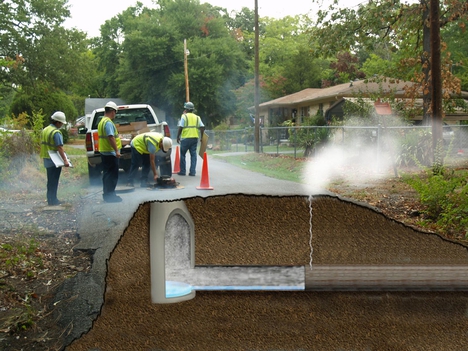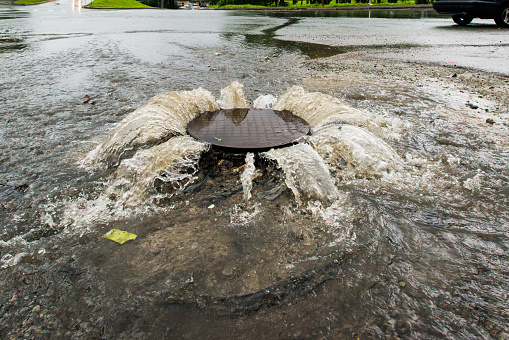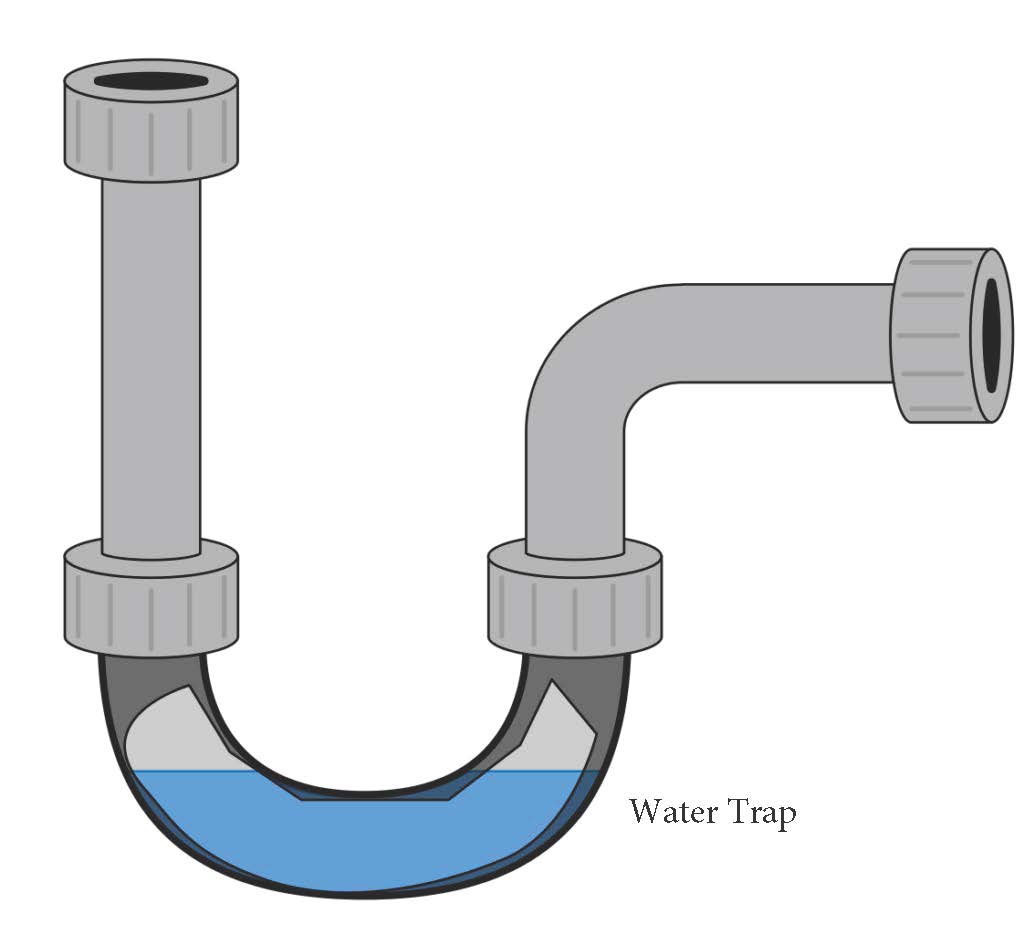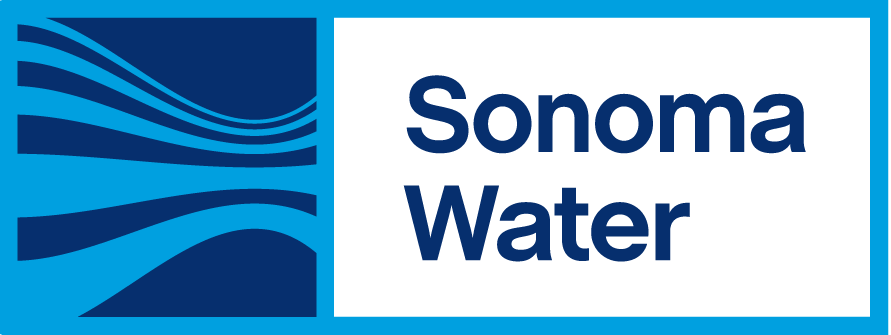A smoke test is a sewer inspection method in which a non-toxic smoke, approved by the Public Health Agency, is blown into manholes. The smoke makes its way through all the connected pipes in the sanitary sewer, helping to locate pipe leaks, broken manholes, cracks, uncapped lines, and more.

This brief video gives a good introduction to Smoke Testing:
English:
Español:
Smoke testing is used to determine if there are leaks and/or cracks in underground sewer lines. The smoke used is non-toxic, non-staining, artificially created, and has a slight odor.
- Pour 1 gallon of water into any drain that is not frequently used. Water will fill the drain trap (also known as the "P-trap") and keep smoke from entering there.
- Drain traps should always be filled with water to prevent sewer gas from entering your home or building.
- Sonoma Water notifies owners with a door hanger and will inform the local fire and police departments of where they will be conducting smoke testing in neighborhoods.
- Smoke is blown into manholes in the street and through the sewer pipes under a slight pressure to help find cracks, as well as unpermitted connections to roof gutters and yard drains.
- If your building's plumbing is properly installed, smoke escapes through the plumbing vents on the roof on your home or business.
- You will be notified if there are any defects identified on your private property.
.jpg)
- Ventilate rooms by opening windows or doors. The smoke inspection may reveal defects are present in the pipes and plumbing.
- The smoke creates no fire hazard and is not harmful to humans, plants or animals. However, if you experience irritation caused by the smoke, leave and ventilate the area.
The purpose of smoke testing is to find potential points of inflow and infiltration in the public portion of the sanitary sewer system that could lead to high flows during storms. Smoke testing can also help locate the following:
- Buildings that have downspout, cellar, yard or basement drains, and sump pumps
- Broken or removed cleanout caps.
- Any cross connections between sanitary sewers and storm drains
- Defective sewer connections that could allow sewer gases into a building

No, provided that your plumbing is installed and functioning properly, and provided “traps” are filled with water. Pour 1 gallon of water into any drain that is not frequently used. If you are not sure, simply run water down the drain for a minute to ensure that the trap is not dry. It is important to locate dry traps as they could allow sewer gases to enter the home. Please thoroughly check your home.

While crews might be in your area for a few hours, each actual smoke test setup takes approximately 15 minutes to complete. Most houses will only be within the testing area for one or two tests.
No. Inspection crews will not need to enter your home.
This testing cannot be conducted during rainy periods or very windy conditions, so it can sometimes be delayed. Also, other activities in the project may take less time than anticipated, so it can sometimes be sooner than expected. The schedule may also shift if more or fewer defects than expected are located and need to be documented.
Yes, smoke alarms may be activated during smoke testing. If possible, open windows and/or doors for ventilation. If you have any doubts about the origin of the smoke, assume there may be fire and respond accordingly.
Smoke may be seen coming from roof vents, building foundations, manhole covers or yard cleanouts. Smoke coming from roof vents on the roof of homes is a normal occurrence and indicates to the crews that smoke has filled all sewers.
Yes, sump pumps are illegal connections to the sanitary sewer system. If you have a sump pump connected to the sanitary sewer system, you should disconnect it. If your sewer lateral becomes fully or partially plugged and your sump pump turns on, the water could be pumped into your home through a shower or tub causing tremendous damage.
La prueba de humo se usa para determinar si hay fugas o grietas en las tuberías de drenaje subterráneas. El humo utilizado no es tóxico, no mancha, es creado artificialmente y tiene un ligero olor.
- Derrame 1 galón de agua en cualquier drenaje que no se use con frecuencia. El agua llenará la trampa de drenaje (también conocida como "trampa P") y evitará que el humo entre allí.
- Las trampas de drenaje siempre deben estar llenas de agua para evitar que el gas de las tuberías entre a su casa o edificio.
- Sonoma Water notifica a los propietarios con un colgador de puerta e informará a los departamentos de policía y bomberos locales de dónde realizarán las pruebas de humo en los vecindarios.
- El humo se inyecta bajo una ligera presión en las alcantarillas de la calle y a través de las tuberías de drenaje para ayudar a encontrar fugas, así como las conexiones no permitidas de las canaletas del techo y los desagües del jardín.
- Si la plomería de su edificio está instalada correctamente, el humo se escapa a través de las rejillas de ventilación del techo de su casa o negocio.
- Se le notificará si hay algún defecto identificado en su propiedad privada.
.jpg)
- Ventile las habitaciones abriendo ventanas o puertas. La inspección de humo puede revelar la presencia de defectos en las tuberías y la plomería.
- El humo no crea peligro de incendio y no es dañino para humanos, plantas o animales. Sin embargo, si experimenta irritación causada por el humo, salga y ventile el área.
El propósito de las pruebas de humo es encontrar puntos potenciales de entrada e infiltración en la parte pública del sistema de alcantarillado sanitario que podrían conducir a altos flujos durante las tormentas. Las pruebas de humo también pueden ayudar a localizar lo siguiente:
- Edificios que tienen desagües de bajante, sótano, patio; y bombas de sumidero
- Tapas de limpieza destrozadas o removidas.
- Cualquier conexión cruzada entre alcantarillas sanitarias y desagües de lluvia.
- Conexiones de alcantarillado defectuosas que podrían permitir la entrada de gases de drenaje a un edificio

No, siempre que su plomería esté instalada y funcione correctamente, y siempre que las "trampas" estén llenas de agua. Derrame 1 galón de agua en cualquier drenaje que no se use con frecuencia. Si no está seguro, simplemente deje correr agua por el drenaje durante un minuto para asegurarse de que la trampa no esté seca. Es importante ubicar trampas secas, ya que podrían permitir que los gases de alcantarillado ingresen a la casa. Por favor revise su casa a fondo.

Los equipos de inspección pueden estar en su área durante algunas horas, cada prueba de humo dura aproximadamente 15 minutos en completarse. La mayoría de las casas solo estarán dentro del área de prueba para una o dos pruebas.
No. Los equipos de inspección no necesitarán ingresar a su casa.
Esta prueba no se puede realizar durante períodos de lluvia o condiciones de mucho viento, por lo que a veces puede retrasarse. Además, otras actividades del proyecto pueden llevar menos tiempo de lo previsto, por lo que a veces puede ser antes de lo esperado. La prueba también puede cambiar de fecha si se localizan más o menos defectos de los esperados y es necesario documentarlos.
Sí, las alarmas de humo pueden activarse durante la prueba de humo. Si es posible, abra las ventanas y / o puertas para ventilar. Si tiene alguna duda sobre el origen del humo, asuma que puede haber fuego y responda en consecuencia.
Se puede ver humo saliendo de las rejillas de ventilación del techo, las tapas de las alcantarillas o los drenajes de los jardines. El humo que sale de las rejillas de ventilación del techo de las casas es una ocurrencia normal e indica a los equipos de inspección que el humo ha llenado todas las tuberías.
Sí, las bombas de sumidero son conexiones ilegales al sistema de alcantarillado sanitario. Si tiene una bomba de sumidero conectada al sistema de alcantarillado sanitario, debe desconectarla. Si el lateral de las tuberías de drenaje se tapa total o parcialmente y se enciende la bomba del sumidero, el agua podría bombearse a su casa a través de un drenaje en la tina o bañera y causar un daño tremendo.
